Rocket League: A Beginner's Guide
Become the best Rocketeer in the scene with this beginners guide to Rocket League!
Become the best Rocketeer in the scene with this beginners guide to Rocket League!
Rocket League was released in July of 2015, but fortunately, with the new free-to-play update, it has erupted in popularity, passing CS:GO for most concurrent players at one time. Rocket League is not a game that has much substance from the outside, to most, it is just a game that two teams try to score on each other's net. But, Rocket League is much more than that.
Here is a list of things you should become familiar with as a new player!
Settings
Settings can be daunting on newer players just starting but are not as scary as you think. The “right” camera setting does not exist, and every player will have their preference. Some players figure out their preferred settings by trial and error, and slightly tweak it in-game, whereas other players will use the same settings as their favorite pros.
There is one setting that is used by all players alike; turn off camera shake. Camera shake can be a cool feature for your first couple of games to add more dynamic to the match, but as you progress in the game and hit the ball more often, it will disrupt the fluidity of the match. If you don't know where to start, try Dignitas captain ViolentPanda’s settings.
Camera shake: No
Field of view: 104
Distance: 270
Height: 110
Angle: -3.00
Stiffness: 0.45
Swivel: 5.00
Ball cam: Toggle
Control settings are just as important as camera settings. Each player may have a different layout and finding the right one will, again, be another process. Whether you keep the standard settings or change every button, find what works best for you and use it. If you need a place to start, try ViolentPanda’s control setting as well.
Powerslide: X
Air roll (left/right): LB/RB
Boost: A
Jump: B
Ball cam: Y
Brake: LT
Throttle: RT
Battle Car
Choosing a battle car isn’t too hard for a new player, as most will choose a car based on how cool it looks. Most cars may look different, but Psyonix has confirmed that every car has the same statistics. The Octane will have the same speed, acceleration, and power as the Scarab, and the Scarab will have the same stats as the Merc, and so on. However, one thing does change: the hitbox. There are currently 75 different battle-cars in Rocket League, with only six different hitboxes.
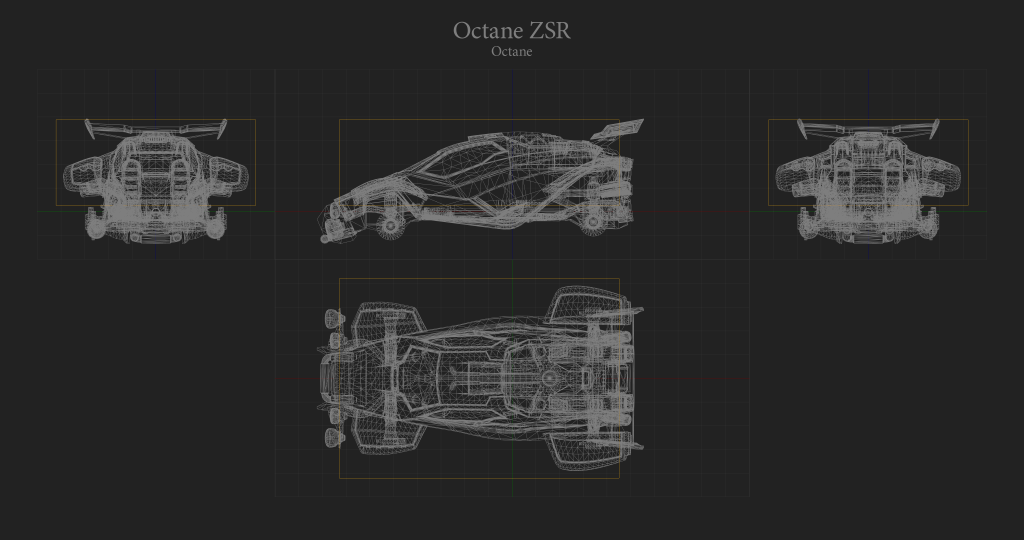
A hitbox is the size and shape a battle car has and the effect it will have on the ball. Pictured above is the Octane ZSR which falls under the Octane hitbox, meaning that any car with the Octane hitbox will have the same outcome in identical circumstances when hitting the ball.
However, most professional players choose one of three different battle-cars, the Octane, Fennec, or Dominus. Which have been proven to be the most well-rounded options in the game at the moment. To find the right car, try what the professionals are using, or test each hitbox to find the one that best fits your playstyle.
Item and Esports Shop
Apart from playing the game, Rocket League uses credits as currency to buy items from the item shop. The item shop updates daily giving good deals on items you may want, and now with update v1.81, players can support their favorite content creators when buying anything from the shop.
The creator code gives that creator a small payout of the credits bought just by entering their code in the item shop. However, anything that you buy in the shop will be on trade lock indefinitely, so you will not be able to trade these for profit or give it to a friend.

There is also another shop specifically for esports cosmetics which allows you to represent your favorite team. This, however, uses a completely different currency from credits called esports tokens. These items are also untradeable.
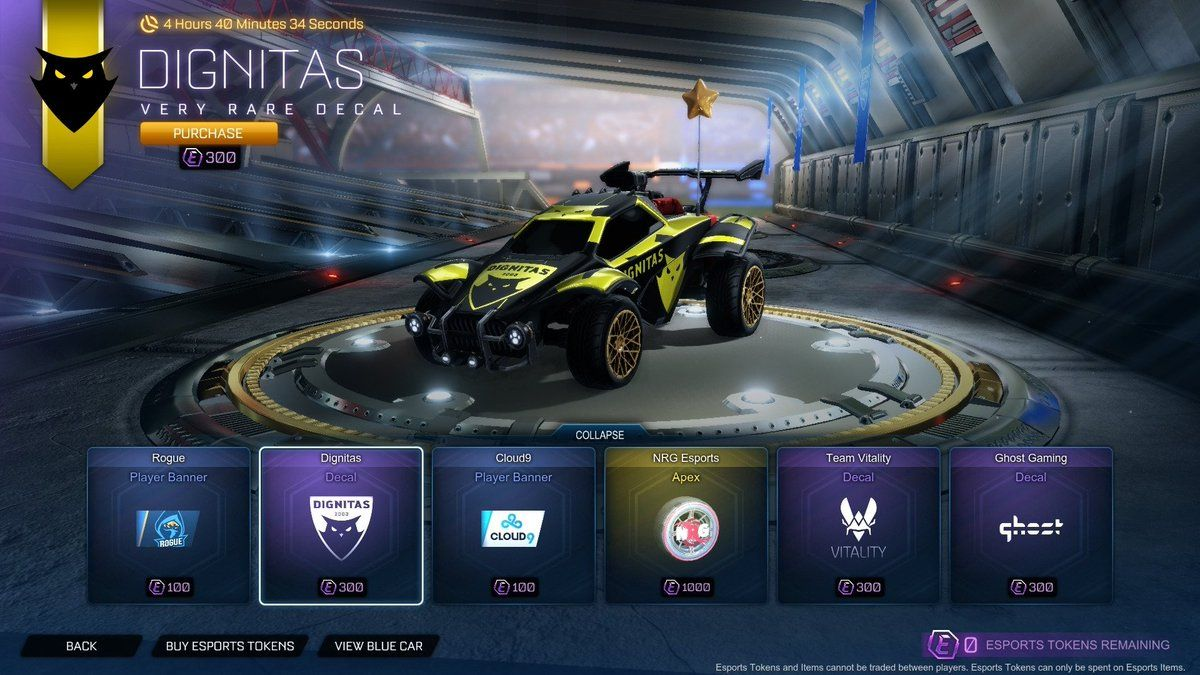
Now that we talked about everything apart from playing Car-Ball, let’s get into the game! Upon joining a match, you may notice you aren’t on the same map as the previous game, or you also may notice the glowing yellow things on the ground, what about the spawn points before kickoff. Every game in Rocket League may play the same or feel the same, but some of these changes make the game feel different every game.
Map Rotation
There are currently twelve different maps that are in the standard map rotation of Rocket League, meaning in the main modes, 1s, 2s, and 3s, there will be no variables to determine your fate. Some of these featured maps are...
DFH Stadium
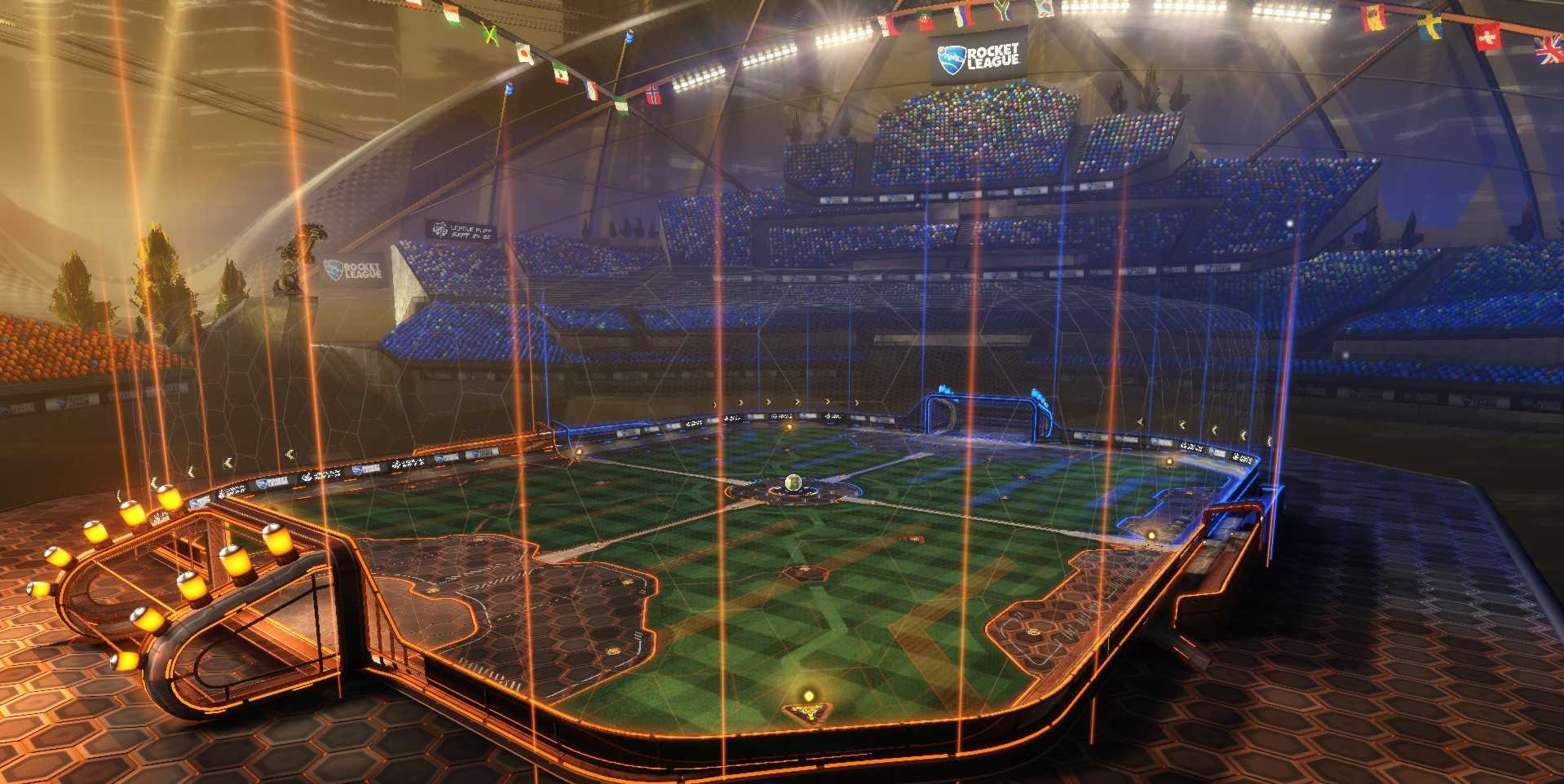
Beckwith Park
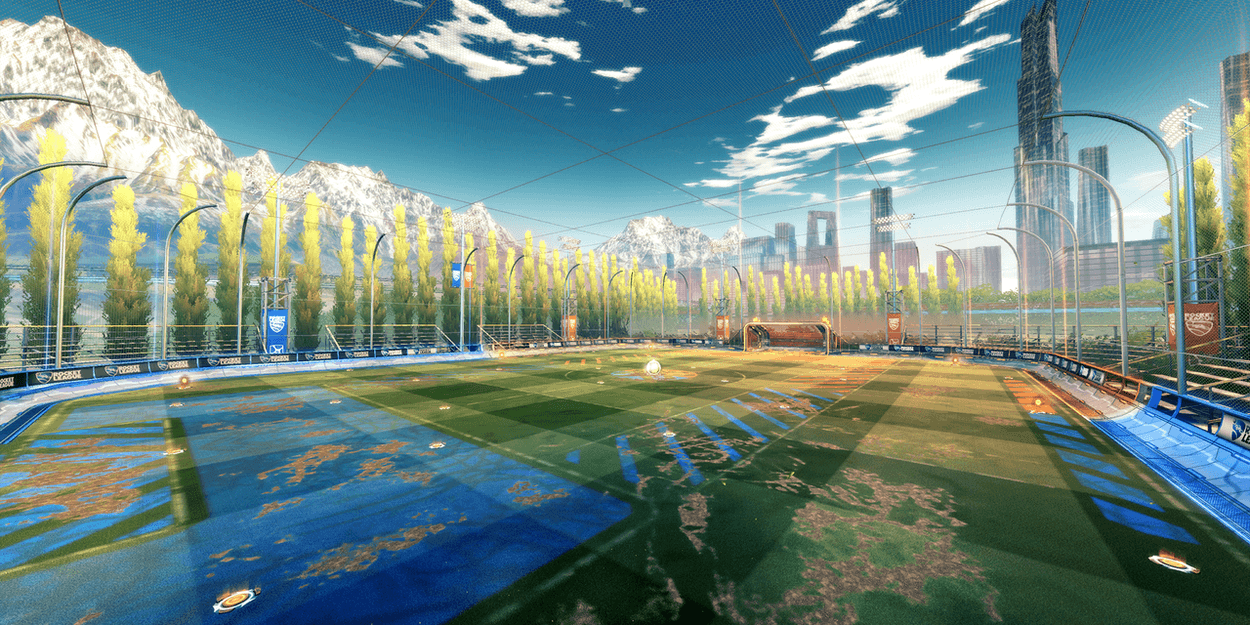
Champions Field

Apart from those twelve maps though, there are also mode exclusive maps as well. Core 707 is a map only featured in Dropshot, as well as Throwback Stadium which is prominently known for the limited mode, Spike Rush. But aside from aesthetics, most maps have a few things in common, the shape and boost.
Every map in the standard rotation, or the maps featured in 1s, 2s, and 3s, (and Chaos mode) will have the same shape, size, and ceiling cap. There will also be boost scattered around the map, allowing you to travel faster than just driving, or flipping, and managing your boost is a key factor that will determine the fate of the match. There are six full boost pads around the map, four in each corner, and two on opposing sides in the middle. The full boost pads are symbolized as yellow, glowing orbs floating over a metal pad, and once picked up, will fill your tank from whatever it is at, to 100. Small boost pads on the other hand, once driven over will give you only 12 boost, but there are more small pads in quantity than full boost. Knowing when to pick up which one is determined case by case, but you will pick up on the boost rotation the more time you put into the game.
Modes
Rocket League offers three different categories to keep players interested and keep the game feeling fresh. Casual is composed up of four different modes, 1s, 2s, 3s, and Chaos (4v4). Casual is mainly used for warming up before heading into competitive, or just having fun with friends who may be lower ranked than you in competitive. You will not rank up, or de-rank in casual, however, you will still gain MMR (Match Making Rating) which will put you against players of similar skill-sets. Casual is also good for learning new mechanics such as wave dashes, ceiling shots or flip resets, or even play-style changes such as rotations or playing more aggressively. Competitive is the next category and is also where the majority of serious gamers will reside.
Competitive is made up of the same modes as casual, apart from the exclusion of Chaos. After ten placement matches, you will be given a rank, this is based on how many games you won, compared to lost during those placements. From there, if you keep winning, you will keep ranking up, and the ranks go as followed Bronze, Silver, Gold, Platinum, Diamond, Champion, Grand Champion, and Supersonic Legend. Each of these ranks will have sub-categories, for example, Bronze 1, 2, and 3, then Silver 1,2, and 3. Going even further, the sub-categories will have subcategories, such as Bronze 1 Division 1, 2, 3, and 4, then Bronze 2 Division 1 2, 3, and 4. These ranks give players something to strive for each season and see their progress the more they play.
At the end of the season, Psyonix puts out season rewards, these are in-game items that players can equip to show off their highest rank they've reached from previous seasons, and these rewards can be in the shapes of wheels, boosts, banners, or even goal explosions. The last category Rocket League has to offer is Extra Modes. Hoops, Dropshot, Snowday, and Rumble can all be found here, and much like competitive, you do get ranked in any of these modes. Dropshot is a game-mode where your main objective is to hit the ball on the opponent's floor, much like volleyball, this will cause the floor to break and leave holes which will, in turn, act as the goal.

Hoops is shadowed off of basketball, where you have to score the ball in the opponent's hoop using things such as the walls, ceilings, or ground to score. Snowday resembles Hockey, where the ball is now a puck and you have to put it in the opponent's net, and lastly Rumble. Rumble is the most popular of the extras mode because it is so different than anything else in the game. Every ten seconds you will be given a power-up based upon randomization, and you will use this item to try to maximize your chances of scoring. Each extra mode also awards its own title if you achieve the highest rank in it (Grand Champion was the highest rank before Supersonic Legend, so my examples will be off of season 14), Hoops is Season 14 Dunk Master, Snowday is Season 14 Blizzard Wizard, Dropshot grants Season 14 Floor Destroyer, and lastly Season 14 RNG Champ for Rumble.
Whether you want to take Rocket League seriously and play competitive, or just play it for fun in casual, Psyonix did a great job bringing a nice balance in the game to accustom most of its players. Even if you get bored doing the same things, you can switch to any extra mode to make the game feel that much different.
Training
Aside from playing against opponents, training is where most players will be spending a lot of their time. Training acts as a catalyst to ranking up, whereas the more time you spend doing it, the better you will get.
Bronze and Silver ranked players may use training as a way to hit the ball and understand how it moves, having an edge against opponents who may not have utilized it. While Grand Champions, on the other hand, may use training to learn a certain mechanic, allowing for more scoring opportunities.
Regardless of what you’re practicing, training will help you reach ranks that you may not have reached without it.
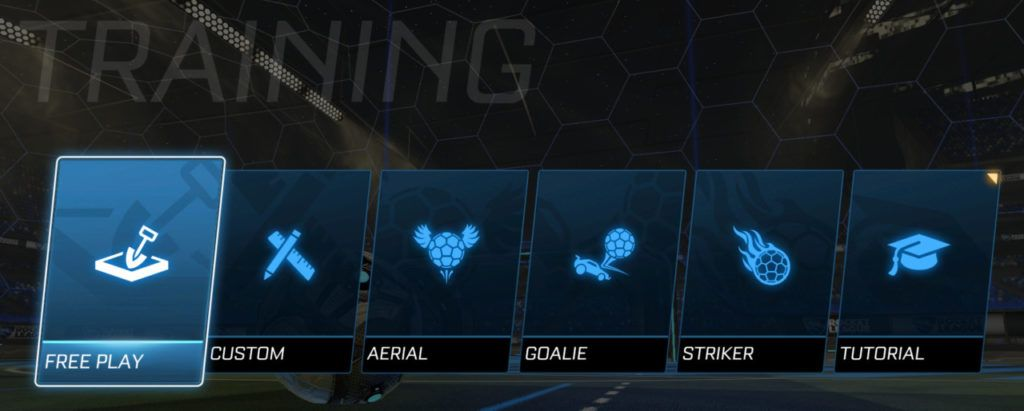
Custom is a collection of training packs made by players to help others work on a specific mechanic. There are training packs as general as saving the ball, and shooting on target, to setups for ceiling shots and air dribbles. I’ve compiled a few training packs that are designed to help novice players below.
Novice Aerials: 0A40-E21D-61C1-49C6
Novice Rebounds: C64E-54EA-FA78-707E
Novice Clears: E530-9668-C5B6-086F
Novice Striker: 137F-0F44-6FA1-91EE
Novice Defender: 87E8-773A-CBE5-B2C3
Rocket League is a rapidly growing game, with an amazing community and great competitive scene that will keep growing despite being five years old. The free-to-play update has shown that Rocket League is nowhere near dead, and will continue to grow larger and will surpass other titles just like it did with CS:GO. Now, go out there, utilize everything you have learned, and dominate the field Rocketeers!